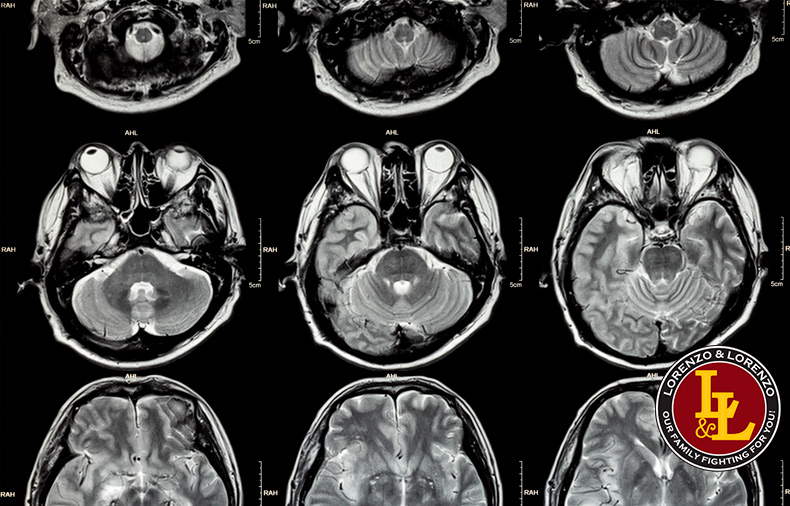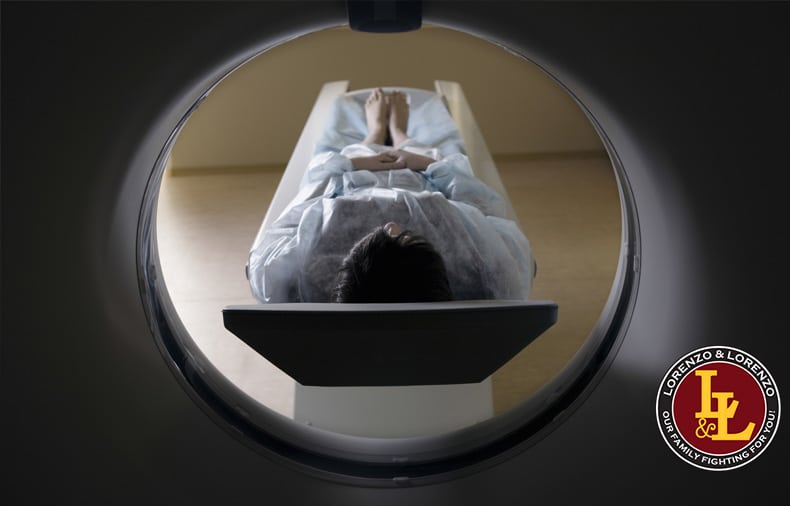
Have you or someone you loved suffered from a brain injury?
When someone suffers a traumatic brain injury, especially because of someone else’s careless actions, it can create detrimental, long-lasting effects. In many cases, traumatic brain injuries change people’s lives forever. Working with an experienced brain injury lawyer is crucial for sufferers to get the compensation they deserve.
Recovering damages through a brain injury lawsuit requires detailed investigation and understanding of the terminology used by insurance adjusters and doctors while your case progresses.
The following details can help you understand the terminology and give insight into the personal injury claim process for a brain injury claim.
What is a traumatic brain injury (TBI)?
Traumatic brain injury (TBI) can occur to the skull, brain or scalp. Potential complications and necessary medical intervention will depend upon the location and severity of the brain injury.
It’s important to understand how physicians and insurance companies handle head and brain injury cases. If you have sustained a traumatic brain injury, it is imperative that you consult with an attorney experienced with traumatic brain injury law.
A traumatic brain injury (TBI) occurs when you suffer from a violent jolt or blow to your head or body that causes bruising, swelling, tearing, or bleeding within your brain’s tissue.
Potential complications and necessary medical intervention will depend upon the location and severity of the brain injury.
Any damage to your brain can potentially change how your body functions, which is why brain injuries often create detrimental life-altering outcomes for victims and their families.
Catastrophic Injury Compensation for Internal Bleeding
Did you suffer from internal bleeding after an accident? Learn what qualifies as a catastrophic injury and what you can do to get compensation.
Common examples of head and brain injuries
Different types of traumatic brain injury include:
#1: Concussion
A concussion is considered a minor brain injury resulting from an impact to the head, shaking or a sudden movement like whiplash. Frequently, a concussion will not show up in an imaging test. However, they should be considered serious and treated appropriately.
You may experience headaches, memory loss, problems with concentration and disorientation. Concussions can be dangerous if you have multiple concussions over time, or if you sustain a second concussion before the first heals. This is known as Second Impact Syndrome (SIS).
#2: Contusion
A contusion is when your brain tissue bruises. Similar to a bruise on your skin, contusions result from the leaking and breaking of small blood vessels. The leaking may cause many issues that relate to the build-up of pressure.
Brain contusions may result from any impact to your head. For instance, a contusion may happen in an auto accident if your head hits the steering wheel.
If you experience an impact to your head, your brain may sustain a contusion directly under the impact site, on the opposite side of the impact (when the brain is slammed against the other side of the skull), or both. These are categorized as either “coup” or “contrecoup” brain injuries.
Similar to concussions, contusions may range from minor to very severe. Severe contusions may result in confusion, loss of consciousness, emotional distress, exhaustion or agitation. Severe contusions can cause brain swelling, prevent oxygenation and other serious health consequences.
#3: Penetrating injury
A penetrating brain injury happens when an object pierces through your skull. That object, skin, hair or fragments of the skull may make contact with your brain. The force and the contact with a foreign object may cause severe injury to a specific area or could injure a large portion of the brain. This can happen in a car accident, for instance, when a piece of broken windshield penetrates or breaks the skull.
#4: Anoxic brain injury
Anoxic brain injury happens when your brain fails to receive enough oxygen to function properly. It takes only 4-5 minutes without enough oxygen for brain cells to start dying. Because your blood carries oxygen to your brain, anoxic brain damage frequently happens due to a blockage of blood flow.
A blockage may happen due to a stroke, blood clot, heart attack or trauma. It is also possible for blood flow to be normal, but the blood isn’t carrying enough oxygen. This may be due to drowning, poisoning, choking, carbon monoxide poisoning, suffocation or an event that prevents the lungs from absorbing a normal level of oxygen molecules.
#5: Subdural hematoma
Injury from blood flow blockages to the brain, like blood clots, severe trauma, stroke or heart attack. They are also caused by a lack of oxygen from drowning, suffocation, or carbon monoxide poisoning, among other causes.
#6: Hypoxic brain injury
When the brain receives some oxygen but not enough to function normally. Often due to near- drowning or near-hanging, cardiac arrest, or exposure to poisonous gasses or carbon monoxide.
#7: Second impact syndrome
A second brain injury, such as a second concussion. If you have multiple concussions over time, or if you sustain a second concussion before the first heals. This is known as Second Impact Syndrome (SIS). A second injury is much more likely to cause severe damage, even if it seems minor when it happens.
#8: Brain bleeds
Known as intracranial or cerebral hemorrhaging, brain bleed occurs when blood has leaked into the brain or between the brain and the skull. Brain bleeds can cause permanent brain damage or death if not treated.
#9 Diffuse axonal injury (DAI)
DAI is a severe brain injury caused by rapid head movement that stretches and tears nerve fibers in the brain. This type of injury often leads to significant cognitive or physical impairments and, in many cases, coma.
What are the most common causes of brain injuries?
Traumatic brain injuries (TBIs) are caused by a range of accidents, with falls being the most common. According to data from the Centers for Disease Control and Prevention (CDC) spanning from 2018 to 2019, unintentional falls were responsible for approximately 29.9% of all TBI-related deaths, an annual age-adjusted rate of approximately 4.6 cases per 100,000 people in the U.S.
Whether in grocery stores, restaurants, parking lots or recreational areas like pools, falls continue to be a leading cause of TBIs, especially among children and the elderly.
Aside from falls, other common causes of brain injuries include the following:
- Motor vehicle accidents. Car accidents, truck accidents, motorcycle crashes and pedestrian accidents are all common causes of TBIs. The sudden impact and force associated with these accidents can lead to head injuries, ranging from mild concussions to severe brain trauma.
- Bicycle accidents. Cyclists are vulnerable to head injuries in accidents involving collisions with vehicles or falls from their bikes. Wearing helmets significantly reduces the risk of severe TBIs in bicycle accidents.
- Sports and recreational activities. Contact sports like football, soccer and hockey, as well as activities like skateboarding, horseback riding and water skiing, pose a risk of head injuries. Athletes can experience concussions or more severe TBIs due to collisions or falls during play.
- Acts of violence, including physical assaults and domestic violence, can result in traumatic brain injuries. Blows to the head, such as punches or strikes with objects, can cause significant harm to the brain. Dog attacks are another frequent cause of this type of injury.
- Shaken baby syndrome. Infants are particularly susceptible to TBIs, often due to abusive shaking or blunt-force trauma to the head. Shaken baby syndrome can lead to severe and long-lasting brain damage.
- Penetrating injuries. Objects like bullets or sharp debris can penetrate the skull, causing direct damage to the brain. These penetrating injuries can occur during vehicle accidents, explosions or assaults, and they require emergency medical intervention.
Preventative measures, such as wearing helmets, practicing safe driving, and addressing violence and abuse, can help reduce the risk of TBIs associated with these common causes.
What are the levels of severity of traumatic brain injuries?
The symptoms of a brain injury can show up differently from one person to the next. Many traumatic brain injury symptoms are subtle or do not appear immediately, and it is critical to seek a doctor’s assessment of the injury’s severity.
There are 3 levels of TBI injuries.
- Mild. This may involve a loss of consciousness for up to a few minutes, but not always. The victim may be disoriented or confused. The injury may not show on medical tests, so doctors need to rely on observations of mental functioning to diagnose concussions and mild TBIs.
- Moderate. Symptoms can involve loss of consciousness for a few hours, confusion, and other complications lasting for weeks or months. The complications could become permanent, with cognitive, physical, or behavioral issues requiring several treatment programs.
- Severe. This level of injury often involves open-head injuries with severe skull damage.These brain injuries, often due to penetration or a crushing blow to the skull, are life-threatening and life-changing. The victim rarely returns to their previous way of life.
What are the symptoms of TBI?
Brain injuries can have various physical, sensory, and cognitive effects. While some symptoms appear right after the traumatic injury, others take several days or weeks to appear. Following are some symptoms of mild and moderate TBI.
Mild TBI symptoms
Physical:
- Headache, fatigue, drowsiness
- Nausea or vomiting
- Speech problems, dizziness, loss of balance
Sensory:
- Light or sound sensitivity
- Issues with the senses, such as ringing ears, a bad taste in the mouth, blurred vision, or changes in smelling ability
Cognitive, mental or behavioral:
- Confused, dazed or disoriented state
- Loss of consciousness for a few minutes or seconds
- Problems with memory or concentration
- Mood swings or changes, feeling anxious or depressed
- Sleeping much more than usual or having difficulty sleeping
Moderate or severe TBI symptoms
For more serious brain injuries, victims may display more severe versions of the mild brain injury symptoms, such as losing consciousness for a prolonged time. Dilated pupils, seizures, loss of coordination, or profound confusion indicate severe brain injury. Slurred speech, coma, clear fluid draining from the ears or nose, or agitated and combative behavior can also result from more serious TBIs.
What are the possible complications of TBI?
The potential short-and long-term complications from a TBI are many and varied. Some show up immediately after the injury. The number and severity of complications increase with more severe brain injuries.
Examples of complications include:
- Changes in consciousness, such as minimal consciousness, coma, vegetative state, or brain death
- Physical issues include seizures, vertigo, headaches, damaged blood vessels, and fluid buildup that causes pressure and swelling in the brain
- Cranial nerve damage that can cause loss of hearing or vision, double vision, ringing in the ears, facial paralysis, and problems swallowing
- Intellectual problems involving memory, learning, concentration, and executive functioning, such as decision-making and organizing
Other complications include mild to severe changes in the ability to communicate, moderate behavior, and manage emotions. TBIs may also expose individuals to degenerative brain diseases such as Alzheimer’s or Parkinson’s, although the link is still under investigation. TBIs can also lead to paralysis.
Can you fully recover from a TBI?
The potential for a full recovery from a traumatic brain injury (TBI) depends on various factors, including the severity of the injury, the promptness of medical treatment, and individual differences in healing and resilience.
In milder cases, such as concussions, many individuals can fully recover with time and appropriate care. Symptoms like headaches, dizziness, and memory problems may gradually improve, and individuals can return to their normal activities.
However, for moderate-to-severe TBIs, the prospects of a full recovery are often less certain. These injuries can lead to long-lasting or permanent impairments, including cognitive deficits, motor skill limitations, emotional and behavioral changes, and even physical disabilities.
Rehabilitation and ongoing medical care can help improve functioning and quality of life, but some individuals may continue to experience challenges and require support throughout their lives.
How do you prove negligence in a brain injury lawsuit?
Many TBIs carry life-long consequences, costing victims their ability to work and adding the burden of ongoing medical expenses for long-term treatment. The medical journal Brain Injury states that within the two years following a brain injury, only 40% of TBI victims can return to their jobs.
To gain monetary compensation in your brain injury case, four elements must be proven to establish whether negligence existed. The elements to prove are a duty of care, breach of that duty, causation, and damages. If even one of these elements cannot be proven, you may not receive the compensation you need and deserve.
Duty of care
The duty of care involves a party’s legal obligation to avoid injuring others by using reasonable care. In some cases, such as a brain injury resulting from an auto accident, duty of care is relatively easy to prove. Every driver is legally obligated to drive their car safely. Duty of care becomes harder to establish if an injury happens on someone else’s property. The property owner’s duty of care is highly subjective and dependent on several circumstances.
Breaching the duty of care
Breach of the duty of care is the next element to prove. The victim, or defendant, must prove that the other party violated their duty of care to receive monetary compensation. When someone breaches their duty of care, it could include:
- Driving recklessly
- A violent assault
- Drunk driving
- Failing to repair items like loose or broken handrails
- Committing an error during a brain surgery
Whether a breach occurred will be determined based on facts regarding the injury.
Linking causation
You may be able to receive a monetary compensation award from the responsible party in a brain injury lawsuit, but you must show that their irresponsible actions caused your injury.
For example, if your injury occurred before the breached duty of care, that injury cannot be considered in a claim for traumatic brain injury.
Damages
To receive monetary compensation, you must prove that you suffered damages. You could have suffered from the loss of wages, the cost of your medical treatments, pain and suffering, expenses related to your disability, and other damages. A successful TBI claim will require detail and proof to support these damages.
Florida personal injury statute of limitations
There are various statutes of limitations for different types of personal injury cases in Florida (medical malpractice, auto accidents, premises liability, etc.)
Get help from an experienced Tampa brain injury lawyer
Brain injuries can be expensive to recover from (if you ever do) and your insurance company will want to spend as little as possible on the recovery. Don’t try to represent yourself when facing insurance claims. They can be complicated and time-consuming, and you’ve already been through enough.
If you or a loved one has sustained a traumatic brain injury from an accident, contact an attorney with experience in traumatic brain injury law. The skilled team at Lorenzo & Lorenzo is equipped and ready to fight for you.








